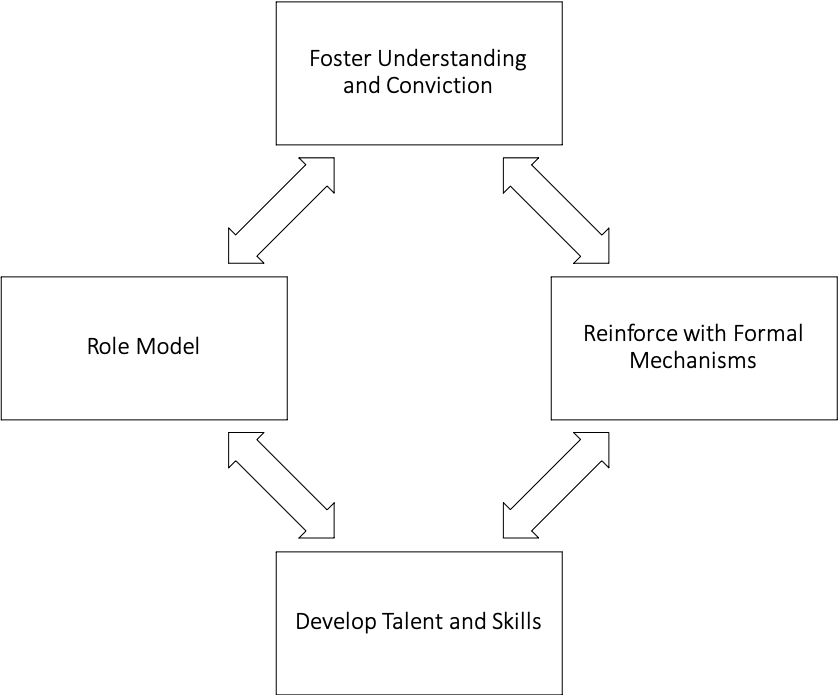McKinsey’s Influence model of leading change [1]lays out four key things that leaders need to do to ensure that they can effectively lead change. Each one of these steps affects how people on the receiving end think about and experience change. As leaders and consultants, if you get these aspects right, then you may experience successful change in mindset and behaviors as you desired.

Foster Understanding and Conviction
As with all change models, one of your first activities when leading change is to get buy in. The people you are asking to change should understand why a change is in their interest or important. Furthermore, you should catalyze their willingness and determination to change. There are several ways to develop their understanding and conviction.
First, we know that people are emotional beings. Hence, connect with stories and emotional content. Connecting to them through such content is much stronger than through facts and data.
Next, we also know that people relate to things or ideas that they create themselves or contribute to. Hence, it’s worth exploring how to co-create the changes you aim to achieve with your team. Explaining a situation, asking for their thoughts and eliciting feedback on the future roadmap is a great first step.
Remember that people traverse their emotional change journey and responses to change at different paces. Often, the individuals leading change further ahead in the change journey than others. Hence, it’s crucial to slow down, re-iterate key messages and listen to feedback. Often, those leading change think that they have explained and communicated well. However, in reality, their target audience have not understood their messages at all.
Reinforce with Formal Mechanisms
The second step of McKinsey’s Influence Model of Leading Change is to reinforce with formal mechanisms.
Reinforcement theory means that our actions have consequences, either positive or negative. For example, if we do something good, we may receive a good outcome, such as a huge financial bonus. On the other hand, our bad actions may attract a negative outcome, such as a low performance rating or a reprimand.
Such reinforcements steer individuals towards certain behaviors. Consequently, there are many different types of reinforcement mechanisms. For example, we can have informal reinforcement, such as your boss frowning when you make a bad suggestion. Or, the reinforcements could be formal, such as a contractual commission-based bonus structure. Such factors affect individual’s motivations and future behaviors.
When you’re leading change it’s important to make sure that your formal organizational mechanisms are designed to reinforce the behaviors you want. For example, as part of a behavioral change program, start by categorizing your formal mechanisms. Then review them one by one. As you review, change or refine them to ensure that the mechanisms support your desired behaviors. Note that people are clever and will try to game any metrics that you haven’t comprehensively thought through.
Develop Talent and Skills
Change almost always involves the introduction of or moving to something new. Almost always, this entails the need for people to work or behave in new ways. They may need to operate in new structures, use new systems or perform new activities. For a successful change, you need to help people through this process.
You should help people understand the talents and skills expectations and how you will help them acquire those new capabilities. The methods you choose may vary, but you should factor in time to support this aspect of change.
Not only should you help people with the technical aspects of developing skills and capabilities, but also the emotional and personal developmental aspects of learning new skills. For some, these changes can be scary. Every time they try something new, the inherent risks of failure, social threat and emotional investment may dissuade them from subscribing to change at a sub-conscious level.
To overcome some of these challenges, you should accept failure, create a conducive environment for people to experiment and develop new skills, as well as give them time to achieve proficiency in those skills. Hence, you should offer additional coaching to help them with their mindsets and eliminate any negativity and self-talk when learning new things.
Role Model
The last part of McKinsey’s Influence Model of Leading Change is to role model.
Humans are social beings. We pick up social cues from those around us. Often, we often mirror their behaviors. The Pygmalion Effect describes this phenomenon in the work setting. Similarly, the Michelangelo Effect describes our need to converge our behaviors to the expected norms in our personal settings.
As leaders, you cast long shadows. The behaviors that you adopt send signals far and wide within your organizations. Others pay attention to the things that you pay attention to and ignore those that you ignore. If you are in early to office in the morning, others will be. If you permit poor behaviors in meetings, so will others.
So, one of the most powerful tools of leadership is role modelling. As a leader, if you are to lead change well, then you should role model the new behaviors and ways of working that you wish others to adopt. You need to pay attention to the changes and focus on them. After all, if you say they are important and then ignore them, then so will everyone else.
It’s worth noting that thought leaders are hugely important when it comes to role modelling. They are notable influencers within your organizations. Organizational networks are complex and many people develop the social power that you may be unaware of.
Hence, when leading change, it’s important that you try and collect those influential role models to promote the new behaviors or changes you want them to embed.
References
| ↑1 | The psychology of change management |
|---|




